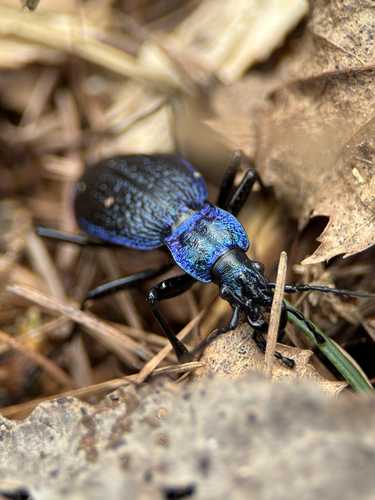
CATERINO Michael
Recommendations: 0
Review: 1
Review: 1

Museomics of Carabus giant ground beetles shows an Oligocene origin and in situ Alpine diversification
Natural history collections continue to inform ground beetle genetics.
Recommended by Felix Sperling based on reviews by Michael Caterino, Julian Dupuis and 1 anonymous reviewerSome of the biodiversity of our planet now exists only in museums, due to continuing habitat destruction and climate change. With more than 380 million entomological specimens already preserved in museums (Johnson and Owens 2023), there is much work left to document what we already have. Fortunately, new advances in DNA sequencing have given us the opportunity to get enormous amounts of information from dried specimens on pins.
One such advance is HyRAD-X, which uses RAD-derived probes originally developed using RNA extracted from a selection of specimens with high RNA-integrity (Schmid et al. 2017). These exome-limited probes can then be used to capture low-integrity DNA extracted from a single leg from museum specimens, followed by Illumina sequencing of the enriched libraries.
Ground beetles allow an excellent demonstration of this approach, as their diversity, large size, and charismatic appearance has led to them being well represented in museums. Using a HyRAD-X probe set previously developed for a higher phylogeny within the subfamily Carabinae (Toussaint et al. 2021), the authors have now applied the same probe set to produce a comprehensive phylogeny for Arcifera, a clade of four subgenera and ten species within the genus Carabus (Pauli et al. 2024).
Of the 96 specimens that they started out with, 90% were from natural history collections and 40% dropped out immediately due to poor DNA extraction yield. After filtering the resulting sequence reads for minimum coverage and minimum number of samples per locus, they ended up with 35 museum specimens with an average of 793 loci. Phylogenetic analysis of this data supported the current classification of these beetles.
Pauli et al’s. (2024) study has effectively shown the power of HyRAD-X methods for applications at the species level. In-house production of probes makes the method accessible, expanding the opportunity to use museum specimens for population genetic research.
References
Johnson KR, Owens, (IFP. 2023) A global approach for natural history museum collections. Science 379,1192-1194(2023). https://doi.org/10.1126/science.adf6434
Pauli MT, Gauthier J, Labédan M, Blanc M, Bilat J, Toussaint EFA (2024) Museomics of Carabus giant ground beetles shows an Oligocene origin and in situ alpine diversification. bioRxiv, ver. 5 peer-reviewed and recommended by Peer Community in Zoology. https://doi.org/10.1101/2024.03.21.586057
Schmid, S., Genevest, R., Gobet, E., Suchan, T., Sperisen, C., Tinner, W. and Alvarez, N. (2017), HyRAD-X, a versatile method combining exome capture and RAD sequencing to extract genomic information from ancient DNA. Methods Ecol Evol, 8: 1374-1388. https://doi.org/10.1111/2041-210X.12785
Toussaint EFA, Gauthier J, Bilat J, Gillett CPDT, Gough HM, Lundkvist H, Blanc M, Muñoz-Ramírez CP, Alvarez N (2021) HyRAD-X Exome Capture Museomics Unravels Giant Ground Beetle Evolution, Genome Biology and Evolution, Volume 13, Issue 7, evab112, https://doi.org/10.1093/gbe/evab112